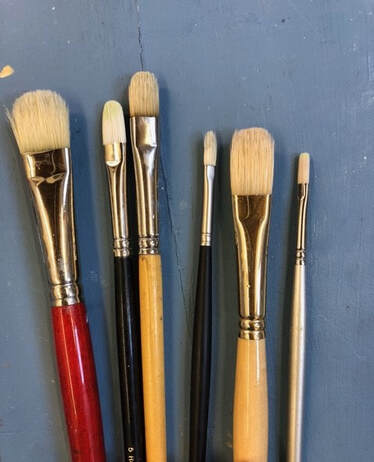Supply List for lessons
Paint (choose any paint manufacturer within your budget) Rembrandt is a good quality paint with a nice soft texture. Daler-Rowney, Windsor & Newton, Grumbacher Academy are all acceptable. You'll need the following colors.
Brushes Hogs hair (varkenshaar) are sturdy and will last. Sostrene Grene also carries decent acrylic brushes. You want larger brushes. See photo. And with filbert (kattentong) bristles. They don't need to be expensive.
Solvent You'll also need a solvent. Gamsol, odorless turpentine, Turpenoid or one of the less toxic solvents is preferred.
Linseed oil In Zwolle, we're very lucky to have a remaining linseed pressing mill! But you can also buy artists' linseed oil from an art shop. Avoid boiled linseed oil and chemically bleached linseed oil. Sun-bleached linseed oil is wonderful. Cold pressed is the finest grade.
2 jars or pots for holding your solvent. One jar is for cleaning brushes, and one jar you'll use to mix a medium and for thinning paint.
Paper towels (keukenroll) or painting rags. You'll need a lot! Keep a roll with your supplies.
Palet You can choose a disposable waxed paper palet to begin with and decide what sort of palet suits you best later. I'll show you the options and tell you the pros and cons of different choices at your first lesson.
A palet knife is very handy. But not necessary for your first lesson. Feel free to send me any questions about materials if you're unsure.
Soap for cleaning your brushes. Ossengalzeep (oxgall soap) is ideal for breaking down the oil in your paint and will help you to get your brushes clean.
- Ivory Black (a cooler black)
- Yellow Ochre
- Cadmium Red (look at the colors available and aim for a middle to warm red). Napthol red can also be used instead of cadmium.
- Titanium White
- Raw Umber
- Ultramarine blue (optional - for later)
Brushes Hogs hair (varkenshaar) are sturdy and will last. Sostrene Grene also carries decent acrylic brushes. You want larger brushes. See photo. And with filbert (kattentong) bristles. They don't need to be expensive.
Solvent You'll also need a solvent. Gamsol, odorless turpentine, Turpenoid or one of the less toxic solvents is preferred.
Linseed oil In Zwolle, we're very lucky to have a remaining linseed pressing mill! But you can also buy artists' linseed oil from an art shop. Avoid boiled linseed oil and chemically bleached linseed oil. Sun-bleached linseed oil is wonderful. Cold pressed is the finest grade.
2 jars or pots for holding your solvent. One jar is for cleaning brushes, and one jar you'll use to mix a medium and for thinning paint.
Paper towels (keukenroll) or painting rags. You'll need a lot! Keep a roll with your supplies.
Palet You can choose a disposable waxed paper palet to begin with and decide what sort of palet suits you best later. I'll show you the options and tell you the pros and cons of different choices at your first lesson.
A palet knife is very handy. But not necessary for your first lesson. Feel free to send me any questions about materials if you're unsure.
Soap for cleaning your brushes. Ossengalzeep (oxgall soap) is ideal for breaking down the oil in your paint and will help you to get your brushes clean.
